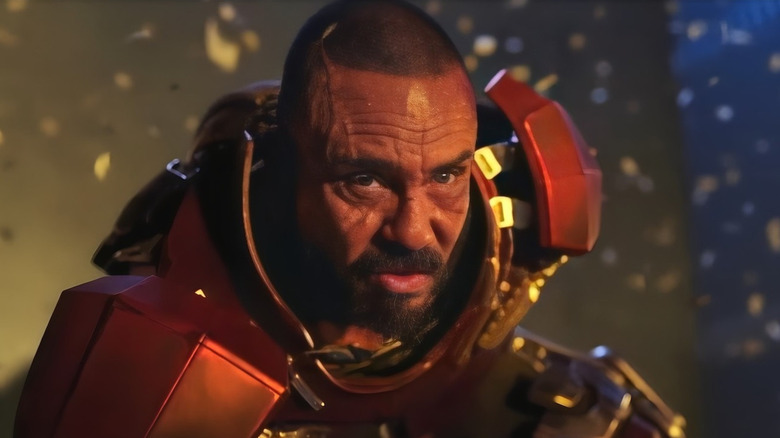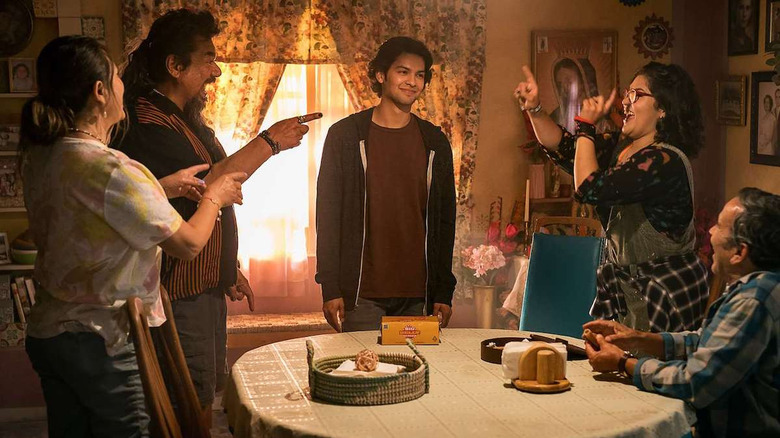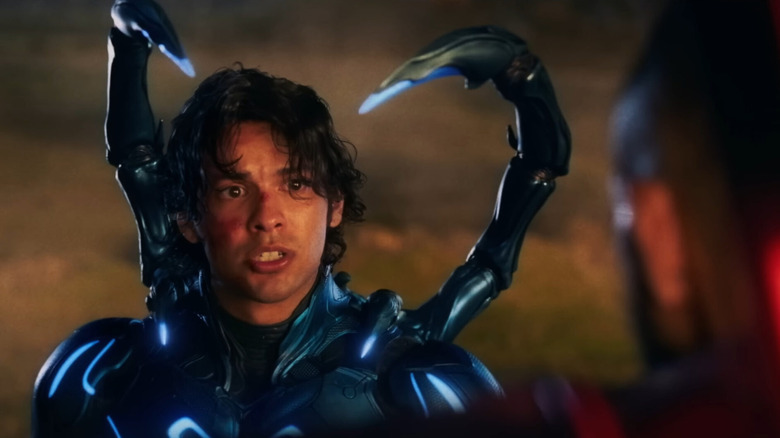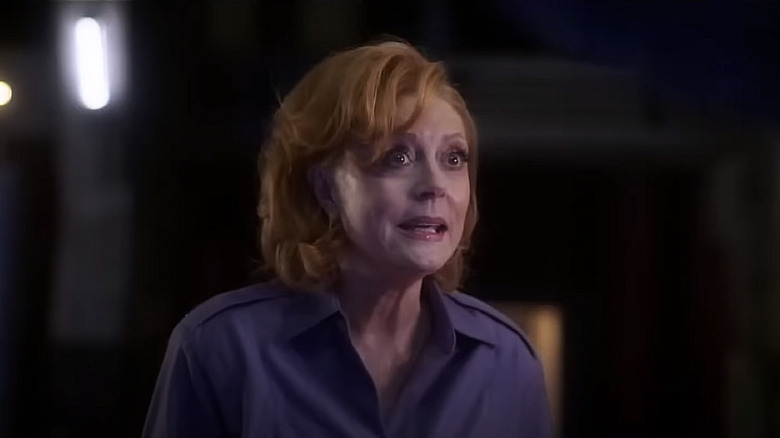Blue Beetle's Villain Has Deep Ties To A Real American Controversy
This article contains major spoilers for "Blue Beetle," so beware!
One of the biggest challenges superhero movies have is giving their protagonist a fully formed and intimidating villain to square off with. For every Thanos and Loki, there are a lot more subpar bad guys like Malekith the Accursed in "Thor: The Dark World" and Taskmaster in "Black Widow." DC Comics movies have had a somewhat better track record when it comes to crafting memorable villains, ranging from various versions of Joker to Michelle Pfeiffer's Catwoman and even Cillian Murphy's Scarecrow. But when it comes to "Blue Beetle," the film's antagonist doesn't quite stick the landing, even though there's an admirable effort to deliver something consequential.
For most of "Blue Beetle," college graduate Jaime Reyes (Xolo Maridueña) is frantically dealing with being involuntarily inhabited by an ancient, cosmic scarab that has fused itself onto his person, complete with some spectacular and entertaining body horror. Unfortunately for him, powerful conglomerate CEO Victoria Kord (Susan Sarandon) needs the scarab in order to effectively upgrade her awaiting One Man Army Corps (OMAC) technology, which she intends to use to create an army of super soldiers, not unlike her personal bodyguard and henchman Lieutenant Carapax (Raoul Max Trujillo). Carapax has endured pain and experimentation in a variety of ways, having had his body repaired with early OMAC cyborg technology, which is also in need of an upgrade.
Throughout the movie, Carapax is treated as a two-dimensional villain with only a small picture locket on his person giving any indication of the character's humanity and history. But Carapax has a past that is hidden even from his own memories, and the third act reveals everything to the audience, complete with a tie-in to a real American controversy that is much more intriguing than the movie has time to properly address.
Pain into power
At the end of the film's second act, Jaime and his family have been beaten down. Victoria Kord has infiltrated their quaint home with soldiers, and the Blue Beetle suit is incapacitated by some kind of harpoon claw weapon aboard Victoria's helicopter above, leaving Jaime vulnerable. Though the Reyes family seems to be out of harm's way, his father Alberto (Damián Alcázar) can't handle all the chaos, and he goes into cardiac arrest. Despite attempts to revive him, the Reyes family loses Alberto, and Jaime is taken away in a helicopter by Victoria and Carapax.
Of course, this allows for the Reyes family to come together in an inspirational and beautiful way. As Nana Reyes (Adriana Barraza) tells the rest of the family in the aftermath, there will be time to cry later. Now is the time to turn their pain into power, as many proud Mexican families have done across generations of oppression and prejudice, so they can save Jaime and honor Alberto.
After a third act full of superhero action and Nana Reyes calling upon her surprising history as a badass revolutionary, Jaime is back in superhero mode with the Blue Beetle suit working with him harmoniously, and he gets his chance to take down Carapax. Filled with anger and a thirst for revenge, he nearly chooses to kill the soldier who's at least partially responsible for his father's death. But the scarab stops his vengeance from being carried out, reminding Jaime that he's not a killer, bringing a true symbiosis to him and the scarab. The scarab goes one step further, too, and it reveals the tragic past that it learned about Carapax while it was being uploaded into his OMAC suit.
The School of the Americas
In a series of quick flashbacks, the scarab reveals that Carapax was orphaned as a young child when Kord Industries and its military clients bombed his village, destroying his home and killing his mother. But the tragedy doesn't stop there. After Carapax was left alone, the military recruited him into "Las Escuelas de Las Americas," or the School of the Americas. Known today as the Western Hemisphere Institute for Security Cooperation (WHINSEC), this institute was founded in 1946 and was responsible for training over 60,000 Latin American military, law enforcement, and security personnel until its closure in 2000.
Why did the School of the Americas close? Well, it had been determined that many of the graduates went on to become dictators, death squad operatives, and assassins. Some of the more infamous alumni include Panama dictator Manuel Noriega and "Maximum Leader of the Panamanian Revolution" Omar Torrijos, as well as Argentina dictator Leopoldo Galtieri and Bolivia dictator Hugo Banzer Suarez. Furthermore, despite being a US government-funded school, the institute used training manuals containing tactics that clearly "violated American policy and principles" (according to the Wikipedia article about the facility).
The initial purpose of the school was to encourage nation-building with American resources, but of course, as with many of the best intentions of the United States abroad, it all went to hell and ended up being a headache that would linger for decades. And don't be fooled by the rebranding to WHINSEC, because it's clear that the school is still very much operating under the same morally and ethically questionable practices that made it notorious to begin with.
The reveal that Carapax was trained in the School of the Americas comes with quite a lot of political and emotional baggage, and even though this reveal paints a brief but complex portrait to quickly reframe a seemingly two-dimensional bad guy into a refreshing backstory, it just might be too little, too late.
'...the reason why he is a villain is because his trauma was weaponized'
There's something to be said about Carapax's history and how it ties into the overall oppression, hardships, and prejudice that millions of Mexican families (and many with Latin American lineage) have faced. The Reyes family took the great sorrow they felt from the passing of Jaime's father Alberto (along with all the pain they've endured by simply existing as a minority) and turned it into the strength to fight back and save this young man, who also happens to be the first Reyes family member to graduate college. Carapax did the same thing. The only difference was his pain was misdirected into the wrong kind of power. /Film's Rafael Motomayor recently spoke with director Ángel Manuel Soto about this element of Carapax, and here's what he had to say:
"To me it was important to explore that, in Hollywood, Latinos are always introduced in the middle of the paragraph. We enter a scene and we're gangsters and narcos, we are violent and dishonest people, and no one questions why that is. When a movie or a show explains why, it just says that we are like that because that's our nature. So we've never been given the chance to explore the history of blood behind the violent behaviors in Latin America."
Soto elaborated on turning Carapax into as much of a victim as he seems to be a villain:
"It was important for me to be able to show this villain, who is not just Latino but indigenous, and show why he is the way he is, to a certain point. Because even though he is responsible for much of his actions, the reason why he is a villain is because his trauma was weaponized. When you see it, you understand he is a victim of the endless perpetuating of violence in Latin America by the CIA through the School of the Americas, but no one talks about that. No one talks about the start of neoliberalism in the School of the Americas in 1973 with the murder of Allende and the placement of Pinochet."
A valiant effort at least
Susan Sarandon's Victoria Kord is a key part of Carapax's depiction as well. Soto explained:
"It is why Susan represents the Military Industrial Complex, and the rampant imperialism that exists in Latin America. She is a person that has been perpetrating trauma, and then using that trauma like the School of the Americas, which trained the locals so they'd invade their own people. There is nothing more nefarious than that, so it was important to me to have that exist in this movie, if only for a minute. Using fantasy to raise curiosity, could help us be better informed and more emphatic."
So it's clear that director Ángel Manuel Soto and writer Gareth Dunnet-Alcocer saved this reveal for the last minute with purpose. Surely, they hope that audiences will suddenly feel the same conflicted emotions that Jaime does. Though angry that Carapax caused the death of his father, Jaime ultimately sees that he's not necessarily the real villain here. We're supposed to understand that Carapax isn't just a mindless bad guy. He's a product of the corrupt practices of an oppressive, careless government that has exploited the tragedies of millions for decades. Whether this sudden shift actually delivers the emotional punch that's intended, well, that's for viewers to decide.
Personally, I wish the superhero side of "Blue Beetle" carried the same heft as the family dynamic and cultural representation. Perhaps the screenplay bites off a little more than it can chew in trying to include some of these details that can't properly be fleshed out in a superhero movie's runtime. Even clocking in at right around two hours, there's not nearly enough time to digest the complicated political and cultural landscapes at play. But at the very least, you have to admire the ambition to add a little more character depth.
"Blue Beetle" is playing in theaters everywhere now.



